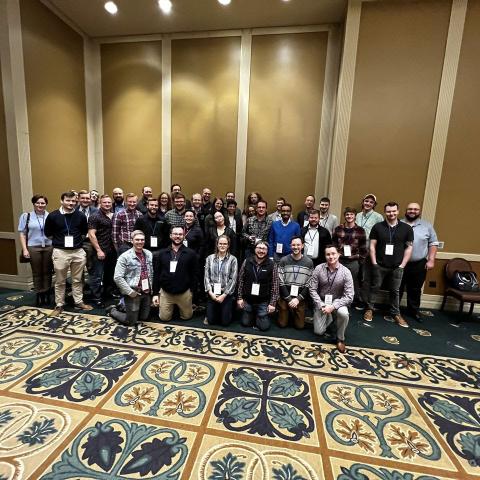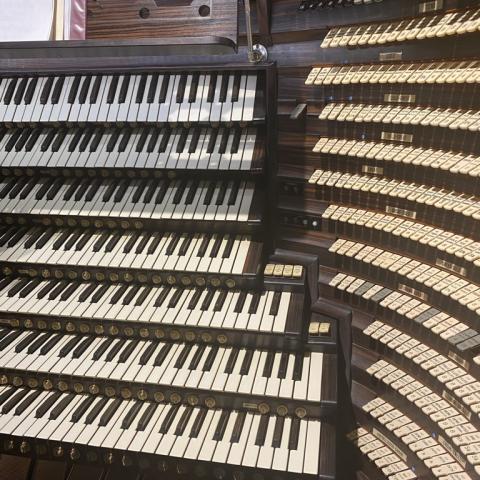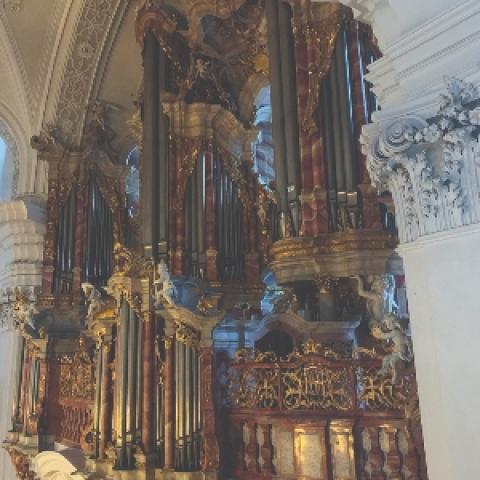
A restoration story
A couple months ago, I wrote in these pages about Fritz Noack, the pioneering builder of mechanical-action pipe organs who learned the trade working for great European firms and came to the United States to build more than 160 organs (see August 2021 issue, pages 14–15). Fritz passed away on June 2 at the age of 86, and I recounted his career in the context of the frenzy of mechanical-action organs, especially as it was centered in the Boston area. At the same time Noack and others were getting started, Nelson Barden was focusing on the restoration of early twentieth-century electro-pneumatic-action organs, the very instruments so many churches were suddenly overly eager to replace.
Nelson was born in 1934 and apprenticed with Roy Carlson of Magnolia, Massachusetts, beginning in 1955, two years before E. Power Biggs brought the iconic Flentrop organ to the Busch-Reisinger Museum (now known as Busch Hall) at Harvard University. Carlson maintained many of the prominent organs in Boston including those in Symphony Hall, First Church, Old South Church, and Second Church (now Ruggles Baptist Church). Early in his time with Carlson, the combination action of a new organ in a junior college auditorium failed just weeks after the dedication concert. The builder of the organ could not solve the problem, and the organist called Roy who in turn sent Nelson to investigate. He noticed that the power-supply feed wires of the combination action were of different colors than those for the organ, and after scouring the building, “discovered” an independent twenty-four-volt generator that powered the combination action. It was turned off. He turned it on. Voilà!
Nelson was quickly recognized as a wunderkind whose aptitude and musical ear equipped him to solve bewildering mechanical glitches, set excellent temperaments, and tune large organs for the most discriminating organists. Those organists began engaging him personally for their maintenance programs, and by the time he was twenty-five years old he was supporting himself with eighteen tuning and maintenance contracts in the Boston area.
The Aeolian-Skinner Organ Company was prominent in Boston and typically restored their own instruments. Second Church in Boston had a forty-five-rank Skinner organ “down front” (Opus 226) and an eighty-three-stop organ by Möller in a rear gallery (Opus 3903), all played from a console located on the floor in front of the congregation, and the organist wished to have the console moved to the gallery. Aeolian-Skinner chose not to bid on the complex project involving a large organ by another builder, and Nelson Barden made what he considered to be a high bid and was awarded the contract. The organist left the church a few years later, and his successor insisted that the console should be moved back to its original location. This time Nelson knew just what the project would cost and accomplished the work with a larger profit margin.
After working from the basement of a friend’s apartment in Brookline, Massachusetts, Nelson found space in the former Chickering Piano Factory in Dorchester, knowing he would have to work hard to meet the $140 monthly rent. By 1963, he had seventy-eight maintenance contracts. When that number had grown to 107 by 1971, he decided to scale back and focus specifically on restoration.
Counterculture
Nelson was establishing his restoration business in the midst of the tracker-action frenzy. Companies like C. B. Fisk, Inc., Noack Organ Company, and Andover Organ Company were producing dozens of new instruments. Nelson told me simply that he was not moved by tracker-action organs, preferring to work on the “gorgeous” electro-pneumatic-action organs
of the early twentieth century, especially those built by Ernest Skinner and the Skinner Organ Company. He gained a deep respect for the innovations that allowed pneumatic actions to work so reliably and sensitively, and developed techniques expressly for this unique work, setting the standards for generations of restorers of pipe organs.
Nelson maintained the fleet of organs owned by Boston University, so naturally he was summoned when John Robinson, secretary of the university’s board of trustees, wished to remove the Skinner organ from his home in Greenwich, Connecticut. A quick inspection of the organ revealed that sewage pipes running through the ceiling of the basement organ chamber had leaked for decades, and he recommended that it would not be practical to restore the badly damaged organ. Mr. Robinson had other ideas. The organ would be restored to museum-quality condition and donated to the university.
BU president John Silber and chairman of the board of trustees Arthur Metcalf came to visit the organ. When Metcalf saw the two-manual Skinner console, he announced, “The organ in my house has three keyboards.” Nelson asked, “Dr. Metcalf, where do you live?” The next day, Nelson and his assistants arrived at Metcalf’s residence in Winchester, Massachusetts, which was originally built for William E. Schrafft, Boston’s “Candy King,” who equipped it with an Aeolian organ.
Dr. Metcalf pressed his hands together and dramatically announced, “I think they should get married,” and the concept of the Boston University Symphonic Organ was born. Nelson Barden & Associates was appointed restorers-in-residence at the university and situated in a fully equipped restoration studio in the Fuller Building on Commonwealth Avenue, built for the Peter Fuller Cadillac-Oldsmobile automobile dealership. It was a blast to drive up the interior circular ramp to Nelson’s fourth-floor studio.
Nelson Barden & Associates worked for more than fifteen years combining the two organs, adding several others, and expanding the instrument to 107 ranks with additional stops and many percussions. Nelson collaborated with his associate Sean O’Donnell, mathematics professor John Irwin, and Roy Battelle to create a sophisticated digital player with advanced editing capabilities, allowing the fragile paper rolls to be transferred to digital files. The organ could be played from both Skinner and Aeolian roll players, the digital system, and from a four-manual Skinner console. It was ultimately installed in Metcalf Hall of the George Sherman Union on the university’s campus, where it was dedicated in honor of president John R. Silber and has been heard by thousands of students and visitors.
The Boston University Symphonic Organ stands as an eloquent example of the art of restoring electro-pneumatic-action pipe organs. Part of Nelson’s vision was that the appearance of a restored organ was important to the overall artistic effect, and along with new techniques for the accurate and intricate restoration of leathered actions, he developed methods for the restoration of the finish on organ pipes, windchests, and all other components of the instrument. Even the screws and hardware were run through bead-blaster cleaning machines to remove rust, adding to the “like new” appearance of the organ. The BU organ is thirty feet tall and one hundred feet wide. Most of the organ is enclosed behind a dazzling array of expression shutters. Visitors walk on parquet floors behind the two stories of chambers. Sliding glass doors allow viewing of each chamber, and polished brass handrails complete the effect. Walking through the organ while it is playing a complex orchestral score is a dizzying experience. You can see photos and read a marvelous essay about the organ written by Jonathan Ambrosino at http://www.nbarden.com/gfx/BUSO-History.pdf.
Nelson Barden & Associates is also well-known for having restored the 113-rank Skinner organ at Old South Church in Boston, and for the creation of the recently completed “Skinner” organ with over 125 ranks for the Church of the Transfiguration at the Community of Jesus in Orleans, Massachusetts, a new installation made up primarily of combined and restored Skinner organs and components.
Passing the baton
When the BU organ was completed and the university needed the studio space in the Fuller Building, Nelson Barden & Associates moved to a workshop space in Waltham, Massachusetts. Having passed his eighty-seventh birthday this summer, Nelson was planning his retirement, aware that he would have to find new homes for the vast collection of wood and metal working machines, hand tools, and other equipment he had accumulated over his long career. He the told me, “I prayed to Saint Cecilia.”
On June 15, news broke of a devastating fire destroying the workshop of Dobson Pipe Organ Builders in Lake City, Iowa. At the time of the fire, Dobson was about a third of the way through the construction of their ninety-ninth organ, a large, new four-manual instrument for Saint James’s Church, King Street, in Sydney, Australia. It was to include a Vox Humana made by the Skinner Organ Company they had purchased from Nelson’s associate Peter Rudewicz, and immediately after the fire, Dobson president John Panning called Peter to ask if a replacement rank was available. There was, and it was soon apparent that one company was eager to sell its equipment and the other was in immediate need of it.
An agreement was quickly reached, and arrangements made to pack and ship the entire contents of Nelson’s workshop to Dobson. The Organ Clearing House helped with the packing and chartered a semi-trailer that turned out to be driven by Bob Mead, one of our regulars. This was the fourth load Bob had hauled for OCH in 2021, and he delivered it to Dobson’s temporary workshop on August 2. It seems a miracle that all that well-seasoned organ building equipment will continue to sing together in the same choir, helping to build organs for the next generation.
It’s all art
I visited Nelson Barden’s workshops many times over the years, both in the Fuller Building and in Waltham. During the restoration of the BU organ, Nelson developed a theatrical lecture presentation of the work they were doing that he first shared with the BU board of trustees. He generously presented it for the staff of my Bishop Organ Company in the late 1980s and famously ran it six times for the national convention of the American Guild of Organists in 1990, and I know that countless others were treated to this show, gaining a higher understanding of the art of the organ and the art of organ restoration. The fastidious details of Nelson’s methods have been applied to the restoration of historic mechanical-action organs, pianos, harpsichords, and many other facets of the world of historical restoration. His career has influenced the preservation of many electro-pneumatic-action instruments that might otherwise have been replaced with new tracker organs.
I believe that the revival of building organs in classical styles has led us all to a higher understanding of the art through the limitless study and experimentation that went into recreating ancient methods. The concurrence of reconstruction of old methods of organ building with the development of new techniques of organ restoration means that the entire art of the organ has been elevated. Today, organ builders in the United States and Europe are building and restoring high quality organs of all types and descriptions.
The evolution of the pneumatic-action and electro-pneumatic-action organ to include expression enclosures and a dizzying array of registration devices invented by such geniuses as Aristide Cavaillé-Coll, Henry Willis, and Ernest Skinner did not sully the reputation or effectiveness of the classic beauties of Arp Schnitger and Elias and George Hook, but added to the breadth and depth of the art. As Silbermann and Hildebrandt organs inspired Bach, so Cavaillé-Coll organs inspired Franck, Vierne, Widor, Dupré, and a host of other great musicians. Ernest Skinner changed the landscape forever with his colorful tonal innovations, elegant consoles, and the spectacular design of the pitman windchest that sports the fastest and quietest stop action of any pipe organ—even a careless user cannot make it noisier. The vast repertory of music for the organ from Scheidt and Sweelinck through Demessieux and George Baker is only possible because of the huge variety that is the world of the pipe organ.
I am often asked what is my favorite organ, a question I find impossible to answer. I might say it is the last organ I heard, but that one might have been a stinker—there is such a thing. There are some iconic “best in the world” organs, and those I have played are worthy of the distinction. I love any beautiful instrument that has been well maintained and loved by the people that own and play it. I love any organ that has been the center of the life of a congregation through generations of festivals, marriages, and funerals. I love a great new organ that is being heard for the first time for the daring and skill of those who made it, paid for it, and prepared a good home for it. I love a beautiful, intimate instrument in a distant local church, and I love a majestic behemoth in a great cathedral or concert hall. I love an organ carefully restored with constant attention to the intentions of the original builder, and I love the first third of the Dobson organ destroyed in the June fire. What matters is that an organ is built with care and integrity, that it is designed with intent and purpose, and that it is faithful to the six-hundred-year legacy of the instrument.
Nelson Barden & Associates and Dobson Pipe Organ Builders are two companies within the same industry with radically different philosophies, methods, and practices. The fact that Nelson’s tools and equipment would be useful to Dobson shows that whether you are restoring a Skinner organ or building a grand new instrument, it is simply all about organs. Both companies devote huge amounts of time and energy to achieving the highest results. Both have raised the standards, inspiring firms across the country with the depth of their work. As Nelson retires from his career and Dobson rebuilds after its fire, the legacy of American organ building flourishes.
Inspiration
In the 1980s and 1990s, I was a newly independent organ guy in the Boston area. I was lucky to work on some of the great organs there and to have contact with some of the “old timers” who had worked with Mr. Skinner. They referred to him formally and with reverence as they came from a time when a young employee would not dream of addressing his boss as “Ernest.” They were in their eighties when I was in my forties. Nelson is of the generation in between. He is a marvelous teacher—there’s a troupe of fine organ craftspeople who got their start in his shop—and he was generous to me with advice and suggestions as I learned my way. After I joined the Organ Clearing House, I collaborated often with Nelson, especially as he sent us across the country to “harvest” the Skinner organs destined to become part of the great instrument at the Community of Jesus.
Helping to move Nelson’s equipment to Iowa has given me a chance to reflect on his contribution to our art. I admire his contrariness, insisting that fine electro-pneumatic-action organs were worth restoring as so many of his contemporaries were newly excited about tracker organs. He helped get us to this place of excellence in every style of organ, and Saint Cecilia was paying attention.





